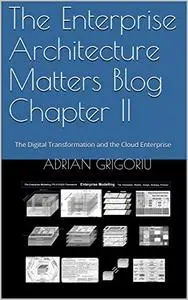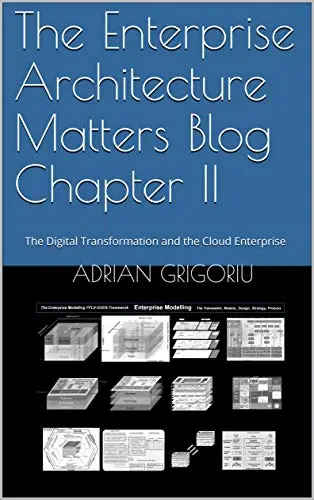The Enterprise Architecture Matters Blog Chapter II: The Digital Transformation and the Cloud Enterprise
By Adrian Grigoriu
English | 2020 | ASIN : B08N41YLK9 | 389 Pages | EPUB | 7.3 MB
By Adrian Grigoriu
English | 2020 | ASIN : B08N41YLK9 | 389 Pages | EPUB | 7.3 MB
The book, the 2nd in the Enterprise Architecture Matters Blog series, reviews the state of the Enterprise which, due to its organic growth, has become unnecessarily complex. A consequence is that over 70% of the Enterprise IT Transformations fail today. The causes are analysed through the eyes of analysts and cures are debated and suggested in the book. Enterprise Architecture (EA) is proposed as a a tool to manage and reduce the today's enterprise complexity and technology debt.
Then Gartner's Enterprise Architecture hypecycle is debated, as is their "Smarter with Gartner" approach.
The Digital fast progress increasingly opens the products and technology (IoT…) to computerised control, automation and enables remote work and access to resources, content and computing power over the Internet… The Digital evolution, better seen revolution today due to its pace, makes possible now the Cloud enterprise, an enterprise which Value and Support Chains links are outsourced to a Cloud of IT and partner services.
Under the assault of the Digital, the Value Chain of IT itself changes though from the legacy Design-Build-Run (DBR) to the Broker-Integrate-Orchestrate (BIO) in KPMG's view. The novel Model-Integrate-Assure (MIA) Value Chain is predicted though in the book because one has to model the Enterprise Architecture before even engaging in change an Enterprise Transformation today. These three mode of IT operation (DBR, BIO and MIA)would co-exist for a long while though. The new and changing roles of CIO, Digital Officer are the object of further discussion.
MIT Sloan's takes on Digital Maturity and Decoupling and McKinsey's view on the Digital Transformation and their Two Speed IT concept are further discussed.
The two digital technologies that change the enterprise and the world today, IoT and 5G, are introduced, as well as the enterprise evolution towards the Cloud technology.
The shallow style of work of today (over 90% time spent in calls, meetings and emails) endangers though the enterprise and its progress, robbing it of the productivity of the willing deep workers which time is hijacked by the shallow work. The Enterprise is also marred today by the absence of a Constitution, fact discussed in the book, which would gather consistently and rationalise the many enterprise values, ethical behaviour rules, guidelines and policies in a single manageable Book of the Enterprise which can be put in practice and enforced to shape the Enterprise Culture and behaviour since Culture is a major roadblock in the enterprise development.
The enterprise is today in search of flatter kinds of organisation in order to increase its output and employee motivation. The Tragedy of Commons, Holacracy organisation paradigms are discussed in this context. The serviced based enterprise approach, enabled and aligned to the Enterprise Architecture, is proposed though in the book to address the enterprise problems of today. Google's thoughts on what a good manager and an effective team are discussed at this stage.
The aim of the book though is to discuss the enterprise Digital Transformation and its failures. UK's Government Digital Initiative is discussed at large.
The blogs in the book often attempt to introduce novel views or debate the opinions held at the time by esteemed analyst companies and colleagues.



